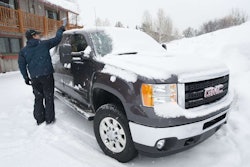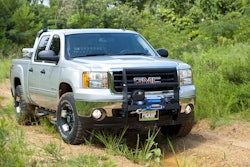ROGER THAT
CB radio buyers guide for pickup owners in the construction trades
by Andrew Youderian, Right Channel Radios
The CB has faded from widespread use since the 1970s, but it still remains a common and useful tool on jobsites and in pickup trucks.
By keeping a few pointers in mind, you can ensure a CB installation that will offer long-lasting, quality performance for your truck.
About CB radios
The first thing to understand about CB radios is that they are all limited by the FCC to 4 watts of output power, which means you won’t get a more “powerful” CB radio by spending more money.
However, stepping up in price will get you more features and higher-quality units.
The one exception to this rule is CB radios with Single Side Band (SSB). These radios can transmit with 12 watts of power, effectively offering three times the range of standard CB radios.
There’s one catch: You can only use this increased range with other SSB-equipped radios.
But if you’re outfitting a fleet of trucks that will primarily be talking among themselves, SSB radios are a great choice to achieve significantly greater range.
Durability and longevity are crucial when selecting a CB. Some radios may hold up fine in a highway- only passenger vehicle or semi, but won’t last long when subjected to the rigors of a work truck.
 Kits like this Cobra 29 pickup package makes it easy to install a CB.
Kits like this Cobra 29 pickup package makes it easy to install a CB.
Nothing is worse than losing communication when you need it, so it’s important to get a proven radio that’s built to take some abuse.
Best CB radios
With this is mind, here are a few specific CB radio recommendations:
For a small, no-frills radio that you can count on, we recommend the Uniden 510. It’s basic but is built extremely well. This radio is alo offered as a complete pickup-ready kit.
For a full-sized radio with a few more bells and whistles – including backlit displays, weather and Bluetooth – choose the Cobra 29 series of radios, which are offered in a pickup-ready kit as well. The Bluetooth Cobra 29 is ideal for contractors.
If you need something small AND loaded with features, the Cobra 75 is a compact unit with a backlist display, channel scanning and weather.
(We don’t recommend using any Galaxy CB radios for work trucks because we have found they typically don’t hold up as well in challenging environments.)
You need to be careful when it comes to powering your CB radio to prevent unwanted electrical interference. Large engines, especially diesel, can create a lot of electrical noise that will distort incoming radio transmissions.
CB Antennas
The antenna is the most important part of your CB installation.
Because CB radios are limited to 4 watts of power, the quality and installation of your antenna will determine your range and performance.
 Fiberglass antennas can be mounted just about anywhere, and their durability makes them a great choice for heavy-duty trucks and equipment.
Fiberglass antennas can be mounted just about anywhere, and their durability makes them a great choice for heavy-duty trucks and equipment.
When it comes to installing an antenna(s) on your truck, there are two types we recommend:
Fiberglass Antennas
Fiberglass antennas are the most popular type of CB antennas for pickups and heavy machinery because they’re durable and can be mounted just about anywhere.
These antennas have a threaded base and are compatible with a wide array of mounts, allowing them to be mounted on everything from vertical surfaces to hood channels to stake holes.
The two most common mounting locations for fiberglass antennas are along the hood channel and right behind the cab of the truck.
Regardless of the mounting location, you’ll want to ensure that the top of your antenna clears the roofline, preferably with at least a third above the roof for decent performance.
The higher the antenna – and the longer it is – the better the performance you’ll receive.
It’s also critical that your CB antenna mount is well-grounded. Otherwise, your system won’t function properly.
Our top recommendation for a quality fiberglass CB antenna is the Firestik FS II CB antenna.
Apart from adding symmetry to a truck, dual fiberglass antennas provide an increase in range over a single antenna installation, especially in a direction parallel to travel.
When installing dual antennas, the farther apart you can get them, the better. Also, make sure to use specially designed RG59 co-phased coax cable, as regular CB coax won’t work.
Magnetic Antennas
The other popular choice for pickups is a magnetic mount antenna. These antennas are all-in-one antennas; the coax, magnetic mount and whip are included a single unit.
They are installed in the center of the vehicle’s roof and are very easy to set up.
Magnetic mount installations offer great performance, usually slightly better than similar length fiberglass antennas.
This is due primarily to their location: The rooftop is the highest spot on the vehicle and is centrally located, which helps with transmission and reception.
On the down side, magnetic antennas are not nearly as durable as fiberglass antennas. The long metal whip can be easily bent and won’t last as long as a sturdy, thick fiberglass antenna.
 Use the best coax you can find for your CB installation.
Use the best coax you can find for your CB installation.
But if you won’t be on a job site that requires a lot of low-clearance vehicle travel, magnetic antennas are a great performance option.
Our top recommendation for a quality magnetic antenna is the Wilson 1000 magnet mount antenna.
Coax and Accessories
There are two primary types of coax cable: RG58 and RG8X.
If at all possible, try to go with RG8X, which is thicker and higher quality, and will last longer when used in a work truck.
If you’ll be using your CB in a really noisy environment like an open-air cab, we recommend an external CB speaker. A CB’s built-in speaker points directly and has a limited wattage, making it difficult to hear in noisy conditions.
Adding an external speaker allows you to move the speaker closer to the vehicle operator and aim it at his or her head for increased clarity of incoming transmissions.
Many radios also support PA horns, which can be convenient while on the job.
As a general rule, try not to run your CB power cord alongside other electrical wires for extended lengths.
 The hood channel is one of the most popular places to mount a CB antenna on pickup trucks.
The hood channel is one of the most popular places to mount a CB antenna on pickup trucks.
If you do experience excessive engine noise, try wiring your CB power leads directly to the battery terminals.
You can also use an inline CB noise filter to reduce electrical interference.
CB Antenna Tuning
Before you begin using your new system, you’ll want to make sure you adjust your CB antenna for peak performance by tuning it with an SWR meter.
Without getting too involved, CB antennas need to be adjusted to match each specific vehicle chassis and mounting location, because the ideal length differs based on these variables.
Using a basic SWR meter (around $25) to take readings, incrementally adjust the length of the antenna until the ideal length is achieved.
Not only does the tuning process ensure peak performance of your CB installation, it also alerts you to any installation or equipment problems that could cause poor performance or even damage.
For more detailed information on the tuning process, please see these CB antenna tuning instructions (https://www.rightchannelradios.com/tuning-cb-antenna-adjusting-swr).
About Right Channel Radios
Right Channel Radios specializes in mobile CB radios and antennas, especially for pickup, industrial and off-road use. You can visit them online at www.rightchannelradios.com.








